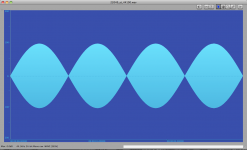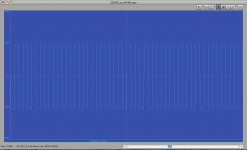I must admit Bob I get very puzzled when people scrimp on speakers, I mean, how long are they going to last and they are by far the most important components in any system?
As long as you are prepared to fool yourself and keep it to yourself, you have my fool sympathy. Once you start fooling others, I am prepared to continue to play my self assigned role as public prosecutor. The gullible have to be protected against charlatans.

Accelerating to G's does not make sense. Hiten for one posted contrary evidence by, I assume, someone who does not have something to sell. If you have an impartial study with real numbers by recognized material scientists I would gladly read it.
It surely is acceleration to 1000s of Gs and there were some publications about elastic deformation and plastic flow of the vinyl as well; but I guess that you're looking for some evidence for another effect.
If it is the high temperature of the tip, then it will get more difficult; Afranovich was sure he could conclude - from his SEB experiments - that vinyl was partly melting during reply but only argued from vinyl replays at different temperatures and that wasn't convincing (at least to me).
It surely is acceleration to 1000s of Gs
G's is not a property an object can have, mass and velocity are. As for the heat imagine the RCA CED stylus at 450RPM, some players were equipped to do a 4 frame locked groove.
Last edited:
G's is not a property an object can have, mass and velocity are.
Why do I feel an urge to scream each time Jakob# begins contorting facts, data, reality, etc...? I know, it's likely the "hate" in me
 .
.Pavel presented foobar ABX evidence, 9 out of 10 right after after some practice. He also said that ABX is much harder than he thought compared to simply listening to a real difference.
How do you feel about ABX being much more difficult than just listening to an real difference, just like the audiophiles have said all along?
I know you can't believe you could be wrong. It happens to people sometimes.
It happened to a lot of medical doctors when Lime was finally shown to be a bacterial infection. Before that there were countless doctors who angrily threw Lime patients out of their office after calling them fakers and malingerers. Don't think the same degree of mistaken belief can't happen in audio, in fact it has. You happen to be a pretty good example of the misguided doctor syndrome as it applies to this field. Best not to be so overconfident if you want to be a good professional scientist.
Thankfully we can very accurately measure things that claims are being made about . . . like cables for example, or silver solder, or DAC's.
Don't know that this type of thing reads across to biological matters that easily other than anecdotally.
It surely is acceleration to 1000s of Gs and there were some publications about elastic deformation and plastic flow of the vinyl as well; but I guess that you're looking for some evidence for another effect.
Yeah everyone (even Lipshitz and Gerzon) started with Hooke's law for stationary deformation then extended that out to a moving stylus. They seem to have copied each other's homework there. It doesn't really make sense to me given the speed the stylus is moving relative to the contact point.
Good found it...
Here's part 3 of my calcs on temperature of stylus and vinyl.
Conclusion from part 1 is that typical heat flow rate at stylus/vinyl contact is of the order of 2mW. Conclusion of part 2 is that whatever the temperaure of the contact region, some 1uW is conducted into the vinyl, and this is effective heating power.
This is part 3 and looks at temperature rise of vinyl near the contact region.
Vinyl contact region continuously changes as record moves.
Assume contact region has a surface radius of 3um, stylus/vinyl velocity = 0.33m/s.
In one second, area swept by contact region A = 3um * 0.33*10E+6 um = 10E+6 um^2
From part 2, heat flow rate into vinyl from contact region P = 1uW
then heat flux into vinyl groove wall Y = P/A = 1uW/10E+6 um^2 = 10E-12 W per um
1um^2 = 10E-12 m^2
then Y = 1 W per square meter
For vinyl groove skin depth of 0.1um, volume swept by contact region in one second V
V= A * 0.1um = 10E+6 um^2 * 0.1 um = 10E+5 um^3
1 um^3 = 10E-18 m^3
V = 10E-13 m^3
Specific gravity of vinyl is close to 1 g/cm^3 = 10E6 g/m^3
Weight of vinyl occupied by volume W = V * 10E6 g/m^3
W = 10E-7 g = 0.1ug
In one second, heat flow = 1 uJ
Specific heat of vinyl is close to 1J/gK
Then average temperature rise T of vinyl groove wall skin to thickness of 0.1um
T = 1 uJ / 0.1ug = 10 deg K (celsius)
Obviously, convenient typical values were chosen to make the math plain, but these choices seem reasonable. Point is, there is not significant heating of the vinyl groove wall skin, not enough to melt or deform.
Jumping a little too fast to conclusions ?
I dont care of the papers of one or another, I trust my ears, taking great care of Group delay in speakers since decades and I can assure-you it makes a difference.
One thing you can verify by yourself, comparing a digital equaliser with an analog equivalent. Reason why so many sound engineers continue to use big analog mixing desks for music.
You've misread the point I was making.
As always, it depends, statistically speaking you could well be one of the 5%ers who perform better and/or worse, depending on your perspective, than the norms who just glaze over very quickly and for whom it doesn't really matter that much......Why do I feel an urge to scream each time Jakob# begins contorting facts, data, reality, etc...? I know, it's likely the "hate" in me.
That's a big can of worms in there. I recall Dr. Hans van Maanen in Linear Audio (vol. 5 if memory serves) promoting the same "time smearing" stuff - and the the tough reprimands he got from Marcel van de Gevel and yours truly.
Long story short, the article you quoted is 50% truth, 50% errors, misunderstandings, and audio mythology.
Is there any other research that counters it, or proves it wrong ?
Maybe the mythology is what needs closer scrutiny instead of dismissal?
Maybe the mythology is what needs closer scrutiny instead of dismissal?
Last edited:
This one might be somewhat related..Scott,
Still thinking of your Cymbal image where you subtracted the before/after filtering time domain envelopes.
There was this unexpected lower frequency in this delta image and at the same time, the higher frequencies above 22050 that were part of the unfiltered version were missing in the delta version.
Since the filtered version was at fs 44100, could it be that the lower frequency below Gibbs in the delta plot was caused by aliasing the frequencies above Gibbs?
If not, what happened to these frequencies above 22050 ?
Hans
Inspired by Scott's suggestion that FFTs should be taken at exact number of bins the sample rate is, I tried to trick FFT analyzers that I have in my DAWs by generating the test files at odd (65536 kHz) frequencies with test tones being at f/2. Guess what - none of the generators that I have were able to produce test tones at exactly the fs/2! No problem with tones at fs/2 + 1Hz or fs/2 - 1Hz, though.
Anyway, to cut the long story short, this is how a sine tones offset by 1 Hz from fs/2 look in time domain - some strange AM! Is this aliasing? (I assume that there is some built-in filter in the generator).
Pictures show 3 sec snippet fully zoomed out and 22049 kHz signal fully zoomed in.
I'd love to hear what you think guys.
P.S Test files are zipped wavs at "regular" 44.1k, not some odd frequencies.
Attachments
Last edited:
Is there any other research that counters it, or proves it wrong ?
Maybe the mythology is what needs closer scrutiny instead of dismissal?
Nobody cares to prove one Doug Rife wrong, life is too short for that. Short of some obvious (but not uncommon) confusions, like between the reconstruction and anti-aliasing filters, the article collides, in the name of the Audio Gods, with some well established facts in digital signal processing and introduces without justification some useless, audio context specific, concepts like "time smearing". These constitute in a body of extraordinary claims, for which extraordinary proof is not provided. There is only one way to separate the grain from the chaff: start reading a good book on digital signal processing (unfortunately not an easy/casual reading) and then the truth will come up clearly. BTW, this is what such authors are relying on: not many are willing to go through such an exercise, and those that already did usually couldn't care less about Doug Rife and his opinions.
You go ahead and scrutinize the mythology, not my cup of tea.
Last edited:
Yeah, you can be sure that when you see the term "time smearing" the author either does not understand what they are talking about or has an agenda.
The only time I've heard of time smearing is in streak cameras, or the super cool time microscope my cubicle neighbor developed when I was interning at LLNL way back when. 🙂
Speaking of the cup, there are those with the cup already filled with audiophile mythology (some post on this thread). You can give them a pot of good tea but when it's poured in, it gets contaminated. It's unfortunate that some of those don't know how to throw out the existing myth out of the cup before refilling with the good stuff.You go ahead and scrutinize the mythology, not my cup of tea.
- Status
- Not open for further replies.
- Home
- Member Areas
- The Lounge
- John Curl's Blowtorch preamplifier part IV

